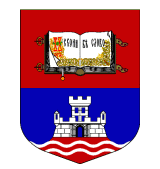European Commission
Project type:
International – Sixth Framework Programme
(Specific Measures in support of International Co-operation Western Balkans Countries)
Duration
2004-2007*
Project Coordinator:
Institute of Chemistry and Technology on Polymers, National Research Council - ICTP-CNR, Naples ITALY
Participants:
Institute of Chemistry and Technology on Polymers, National Research Council, ICTP-CNR, ITALY
Cidemco, Centro de investigacion Tecnologica, CIDEMCO, SPAIN
Mondirect Market, S.L., MONDIRECT, SPAIN
Kenaf Eco Fibers Italia, KEFI, ITALY
Faculty of Technology and Metallurgy, University of Skopje, TMF, R. MACEDONIA
Oktomvri-Eurokomposit, EUROKOMPOSIT, R. MACEDONIA
Institute of Chemistry, Technology and Metallurgy, Department of Electrochemistry, ICTM, SERBIA
Institute for Material Characterisation, USKIM-ZIMRANT, R. MACEDONIA
Studio R- Design, construction, engineering, STUDIO R, R. MACEDONIA
Ministry of Environment and Physical Planning, MOEPP, R. MACEDONIA
Geonardo Environment Technologies, GEONARDO, HUNGARY
Institute of Polymers, Bulgarian Academy of Sciences, IPBAS, BULGARIA
Project Manager:
Maurizio Avella, ICTP-CNR Pozzuoli (Naples), Italy
Number of Researchers:
25
Aim and Scope:
The aim of this project is to introduce a new class of eco-friendly and cost-effective polymer composite construction material. The project addresses combination of European and Balkan scientific and engineering expertise in natural fibre composites, innovative house-component design and construction, low cost – low energy building composites and waste-recycling processes to develop a new generation of housing systems that are environmentally friendly, economically viable and socially desirable. The Eco-houses project related to making life-goods eliminates the consequences of the war in the environment, contributes to the sustainable development and helps to settle and to recover the political, financial and social situation in Western Balkan region.
This proposal adopts an entirely holistic approach to how buildings (particularly houses) should be constructed (and operated) in the future. It will develop and integrate technologies to use new construction materials (based on renewable agricultural resources), innovative component design, ease of assembly, integrated energy generation systems and waste recycling procedures to create housing systems with a much reduced environmental cost.
The ECO-PCCM contribute is the production, through innovation of new class of eco-friendly composite materials with improved engineering properties compared to conventional construction materials and enabling the established of environmental friendly technology. The positive figure that the use of biodegradable plastics as a whole actually saves more oil than needed for their manufacture can be strengthened with an overall lower environment impact.
To develop and produce eco-friendly composites products (objectives of ECO-PCCM) computer-aided material design approach will be applied.
The project addresses many shortfalls in current house design, construction and operation with a view provided by a pan-European, multi-disciplinary team of researchers, engineers, architects and manufacturers.
Major Results:
A different construction composite based on polymers (Polyhydroxybutyrates (PHB), Polyhydroxybutyratevalerate (PHBV), Poly(lactic acid) (PLA), Polypropylene (PP, reference), Polyethylenterephtalate (PET, reference) and natural reinforcements, (Rice straw, Hemp, Jute, Sisal, Cellulose (recycled paper), Kenaf) are realitzed.
See publications for details
Publications:
1. Miriam García, Izaskun Garmendia, Javier García, Influence of Natural Fiber Type in Eco-Composites , Journal of Applied Polymer Science, 107(5) (2008) 2884–3004
2. Maurizio Avella, Gordana Bogoeva-Gaceva, Aleksandra Bužarovska, Maria Emanuela Errico, Gennaro Gentile, Anita Grozdanov, Poly(3-hydroxybutyrate-co-3-hydroxyvalerate)-Based Biocomposites Reinforced with Kenaf Fibers, , Journal of Applied Polymer Science, 104(5) (2007) 3192–3200
3. A. Grozdanov, A. Buzarovska, G. Bogoeva-Gaceva, M. Avella, M.E. Errico, G. Gentile, Nonisothermal crystallization kinetics of kenaf fiber/polypropylene composites, Polymer Engineering & Science, 47(5) (2007) 745 - 749
4. G. Bogoeva-Gaceva, M. Avella, M. Malinconico, A. Buzarovska, A. Grozdanov, G. Gentile, M. E. Errico, Natural Fiber Eco-Composites , Polymer Composites, 28(1) (2007) 98 - 107
5. A. Grozdanov, A. Buzarovska, G. Bogoeva-Gaceva, M. Avella, M.E. Errico and G. Gentille, Rice straw as an alternative reinforcement in polypropylene composites, Agronomy for Sustainable Development, 26(4) (2007) 251 - 255
WEB:
http://elchem.ihtm.bg.ac.rs/ECO-PCCM
Contacts:
Dr. Maurizio Avella, Institute of Chemistry and Technology on Polymers, National Research Council
Olivetti Area, Building 70, Via Campi Flegrei 34, 80078 Pozzuoli (Naples), Italy, E-mail: mave@ictp.cnr.it
